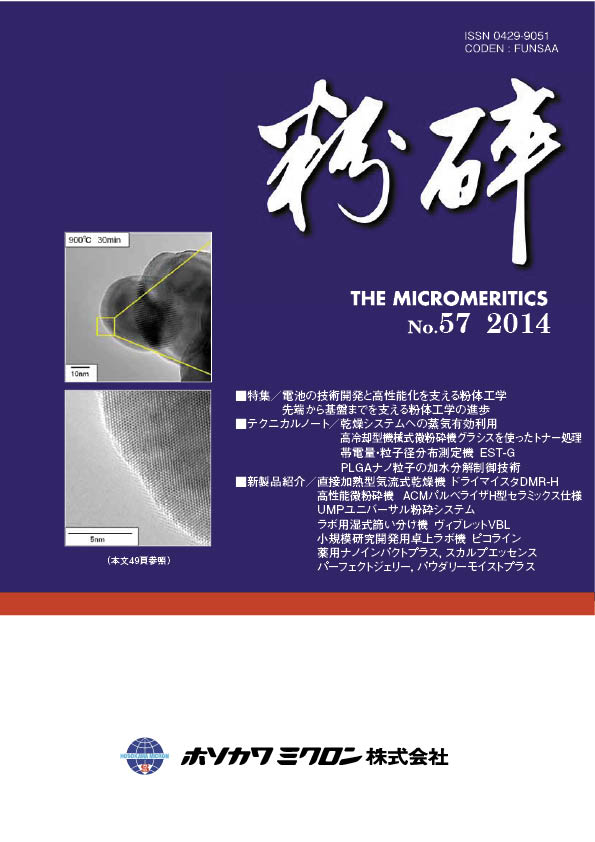Volume 57
Displaying 1-29 of 29 articles from this issue
- |<
- <
- 1
- >
- >|
Front Cover
-
2014Volume 57 Article ID: 2014001
Published: December 10, 2013
Released on J-STAGE: October 03, 2018
Download PDF (332K)
Foreword
-
2014Volume 57 Pages 1-2
Published: December 10, 2013
Released on J-STAGE: October 03, 2018
Download PDF (184K)
Special Subject I: Powder technology for the development and improvement of batteries
-
2014Volume 57 Pages 3-10
Published: December 10, 2013
Released on J-STAGE: October 03, 2018
Download PDF (1015K) -
2014Volume 57 Pages 11-17
Published: December 10, 2013
Released on J-STAGE: October 03, 2018
Download PDF (528K) -
2014Volume 57 Pages 18-21
Published: December 10, 2013
Released on J-STAGE: October 03, 2018
Download PDF (620K) -
2014Volume 57 Pages 22-26
Published: December 10, 2013
Released on J-STAGE: October 03, 2018
Download PDF (709K)
Special Subject II: Progress of powder technology supporting the pioneering technology to the fundamentals
-
2014Volume 57 Pages 27-35
Published: December 10, 2013
Released on J-STAGE: October 03, 2018
Download PDF (1037K) -
2014Volume 57 Pages 36-42
Published: December 10, 2013
Released on J-STAGE: October 03, 2018
Download PDF (1365K) -
2014Volume 57 Pages 43-50
Published: December 10, 2013
Released on J-STAGE: October 03, 2018
Download PDF (1722K) -
2014Volume 57 Pages 51-58
Published: December 10, 2013
Released on J-STAGE: October 03, 2018
Download PDF (1548K) -
2014Volume 57 Pages 59-65
Published: December 10, 2013
Released on J-STAGE: October 03, 2018
Download PDF (858K) -
2014Volume 57 Pages 66-73
Published: December 10, 2013
Released on J-STAGE: October 03, 2018
Download PDF (1487K)
Technical Note
-
2014Volume 57 Pages 74-77
Published: December 10, 2013
Released on J-STAGE: October 03, 2018
Download PDF (834K) -
2014Volume 57 Pages 78-83
Published: December 10, 2013
Released on J-STAGE: October 03, 2018
Download PDF (1527K) -
2014Volume 57 Pages 84-88
Published: December 10, 2013
Released on J-STAGE: October 03, 2018
Download PDF (668K) -
2014Volume 57 Pages 89-91
Published: December 10, 2013
Released on J-STAGE: October 03, 2018
Download PDF (1012K)
New Products
-
2014Volume 57 Pages 92-94
Published: December 10, 2013
Released on J-STAGE: October 03, 2018
Download PDF (726K) -
2014Volume 57 Pages 95-96
Published: December 10, 2013
Released on J-STAGE: October 03, 2018
Download PDF (566K) -
2014Volume 57 Pages 97-99
Published: December 10, 2013
Released on J-STAGE: October 03, 2018
Download PDF (1274K) -
2014Volume 57 Pages 100-102
Published: December 10, 2013
Released on J-STAGE: October 03, 2018
Download PDF (707K) -
2014Volume 57 Pages 103-104
Published: December 10, 2013
Released on J-STAGE: October 03, 2018
Download PDF (564K) -
2014Volume 57 Pages 105
Published: December 10, 2013
Released on J-STAGE: October 03, 2018
Download PDF (353K) -
2014Volume 57 Pages 106
Published: December 10, 2013
Released on J-STAGE: October 03, 2018
Download PDF (351K) -
2014Volume 57 Pages 107
Published: December 10, 2013
Released on J-STAGE: October 03, 2018
Download PDF (317K)
Business Overview
-
2014Volume 57 Pages 108-109
Published: December 10, 2013
Released on J-STAGE: October 03, 2018
Download PDF (573K) -
2014Volume 57 Pages 110
Published: December 10, 2013
Released on J-STAGE: October 03, 2018
Download PDF (240K) -
2014Volume 57 Pages 111-114
Published: December 10, 2013
Released on J-STAGE: October 03, 2018
Download PDF (664K) -
2014Volume 57 Pages 115-116
Published: December 10, 2013
Released on J-STAGE: October 03, 2018
Download PDF (411K)
Topics
-
2014Volume 57 Pages 117-120
Published: December 10, 2013
Released on J-STAGE: October 03, 2018
Download PDF (437K)
- |<
- <
- 1
- >
- >|
